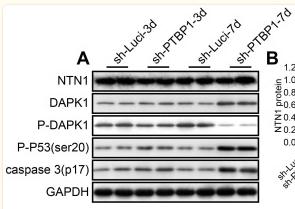Netrin-1 Antibody - #DF8579
| Product: | Netrin-1 Antibody |
| Catalog: | DF8579 |
| Description: | Rabbit polyclonal antibody to Netrin-1 |
| Application: | WB IHC IF/ICC |
| Cited expt.: | WB |
| Reactivity: | Human, Mouse, Rat |
| Prediction: | Pig, Bovine, Horse, Sheep, Chicken, Xenopus |
| Mol.Wt.: | 67 kDa; 68kD(Calculated). |
| Uniprot: | O95631 |
| RRID: | AB_2841783 |
Related Downloads
Protocols
Product Info
*The optimal dilutions should be determined by the end user.
*Tips:
WB: For western blot detection of denatured protein samples. IHC: For immunohistochemical detection of paraffin sections (IHC-p) or frozen sections (IHC-f) of tissue samples. IF/ICC: For immunofluorescence detection of cell samples. ELISA(peptide): For ELISA detection of antigenic peptide.
Cite Format: Affinity Biosciences Cat# DF8579, RRID:AB_2841783.
Fold/Unfold
epididymis tissue protein Li 131P; NET1_HUMAN; Netrin 1, mouse, homolog of; Netrin 1-like; Netrin-1; Netrin1; Ntn 1; NTN 1L; NTN1; NTN1L; Unc6;
Immunogens
A synthesized peptide derived from human Netrin-1, corresponding to a region within C-terminal amino acids.
Widely expressed in normal adult tissues with highest levels in heart, small intestine, colon, liver and prostate. Reduced expression in brain tumors and neuroblastomas. Expressed in epididymis (at protein level).
- O95631 NET1_HUMAN:
- Protein BLAST With
- NCBI/
- ExPASy/
- Uniprot
MMRAVWEALAALAAVACLVGAVRGGPGLSMFAGQAAQPDPCSDENGHPRRCIPDFVNAAFGKDVRVSSTCGRPPARYCVVSERGEERLRSCHLCNASDPKKAHPPAFLTDLNNPHNLTCWQSENYLQFPHNVTLTLSLGKKFEVTYVSLQFCSPRPESMAIYKSMDYGRTWVPFQFYSTQCRKMYNRPHRAPITKQNEQEAVCTDSHTDMRPLSGGLIAFSTLDGRPSAHDFDNSPVLQDWVTATDIRVAFSRLHTFGDENEDDSELARDSYFYAVSDLQVGGRCKCNGHAARCVRDRDDSLVCDCRHNTAGPECDRCKPFHYDRPWQRATAREANECVACNCNLHARRCRFNMELYKLSGRKSGGVCLNCRHNTAGRHCHYCKEGYYRDMGKPITHRKACKACDCHPVGAAGKTCNQTTGQCPCKDGVTGITCNRCAKGYQQSRSPIAPCIKIPVAPPTTAASSVEEPEDCDSYCKASKGKLKINMKKYCKKDYAVQIHILKADKAGDWWKFTVNIISVYKQGTSRIRRGDQSLWIRSRDIACKCPKIKPLKKYLLLGNAEDSPDQSGIVADKSSLVIQWRDTWARRLRKFQQREKKGKCKKA
Predictions
Score>80(red) has high confidence and is suggested to be used for WB detection. *The prediction model is mainly based on the alignment of immunogen sequences, the results are for reference only, not as the basis of quality assurance.
High(score>80) Medium(80>score>50) Low(score<50) No confidence
Research Backgrounds
Netrins control guidance of CNS commissural axons and peripheral motor axons. Its association with either DCC or some UNC5 receptors will lead to axon attraction or repulsion, respectively. Binding to UNC5C might cause dissociation of UNC5C from polymerized TUBB3 in microtubules and thereby lead to increased microtubule dynamics and axon repulsion. Involved in dorsal root ganglion axon projection towards the spinal cord. It also serves as a survival factor via its association with its receptors which prevent the initiation of apoptosis. Involved in tumorigenesis by regulating apoptosis.
Secreted. Cytoplasm.
Note: Mainly secreted.
Widely expressed in normal adult tissues with highest levels in heart, small intestine, colon, liver and prostate. Reduced expression in brain tumors and neuroblastomas. Expressed in epididymis (at protein level).
Research Fields
· Organismal Systems > Development > Axon guidance. (View pathway)
References
Application: WB Species: Human Sample: U251 cells
Restrictive clause
Affinity Biosciences tests all products strictly. Citations are provided as a resource for additional applications that have not been validated by Affinity Biosciences. Please choose the appropriate format for each application and consult Materials and Methods sections for additional details about the use of any product in these publications.
For Research Use Only.
Not for use in diagnostic or therapeutic procedures. Not for resale. Not for distribution without written consent. Affinity Biosciences will not be held responsible for patent infringement or other violations that may occur with the use of our products. Affinity Biosciences, Affinity Biosciences Logo and all other trademarks are the property of Affinity Biosciences LTD.




